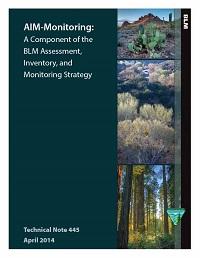AIM-Monitoring: A Component of the BLM Assessment, Inventory, and Monitoring Strategy

The "Bureau of Land Management Assessment, Inventory, and Monitoring Strategy for Integrated Renewable Resources Management" (AIM Strategy) provides high-quality information about ecosystem conditions and trends for decision making. This information, or monitoring data, is essential for the Bureau of Land Management (BLM) to fulfill its multiple-use mission and sustain the diverse uses and benefits of public lands. The purpose of this technical note is to describe the monitoring portion of the AIM Strategy to support implementation across the BLM, thus addressing multiple resource questions at multiple scales. The AIM approach to monitoring features five elements: (1) a standard set of core quantitative indicators and methods, enabling easy comparison of measurements in different places and over time; (2) a defensible and statistically valid way of selecting monitoring plots that informs land management at multiple scales; (3) integration with remote sensing, providing a bird’s-eye view of conditions across the landscape; (4) electronic data capture and management, streamlining information access and application to decisions; and (5) a structured implementation process built on management questions and an understanding of ecosystems. To date, a number of demonstration projects have applied the AIM approach on BLM lands from Arizona to Alaska. These projects focus on a variety of management issues, from aquatic ecosystem health to wild horses and burros. They also address a variety of scales, from local to national. Information derived from AIM-Monitoring is collected once but can be used many times to guide land uses, policy actions, and adaptive management decisions.
